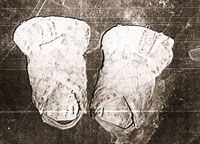
Leather handcrafts in Shabwa: a dying art [Archives:2008/1182/Last Page]
August 18 2008
 |
For the Yemen Times
Generally, everyone has his or her own hobbies or particular business, having an affection for and doing credit to himself or herself. Whoever takes pride in the task, not just to enjoy himself, but also having the courage of his convictions and being convinced that what he's doing comes before all else, is for the best interests of the community as a whole.
For this reason, handcrafts are not shameful or worthy of less status, as thought and alleged. However, some businesses, particularly handcrafters, who are regarded as historical inheritors, are looked upon contemptuously from a narrow perspective, rather than being a matter of taste and choice, selection and decision.
Such professions help one earn a living while at the same time providing pleasure to society; thus, it's all grist for the mill.
Yemen enjoys a variety of customs, traditions and distinguished handcrafts that bear witness to the great culture and heritage it was rich in long ago.
Like other Yemeni regions, Shabwa possesses various types of marvelous and admirable handcrafts that speak for themselves, just one of which are leather crafts. Accordingly, like any part of Shabwa, Wadi Yashbum has witnessed some who have created such handcrafts, which involves nothing but mere animal skins.
In ancient times, the residents of Wadi Yashbum made good use of cattle skins, tanning and converting them into leather, from which numerous useful articles were created to meet the various requirements of that time.
One such leather item was a gareb, an article serving as a good and safe container for fetching, storing and cooling water for a time – or the equivalent of a refrigerator. Another leather item was a shakwah, which served as a churn to convert sour milk into butter.
Other useful objects were made, but in different shapes, such as nahi, garreh, budha and kara'aeh, all of which were used for both sesame oil and nomadic ghee.
Harvest time was represented by other leather articles, for example, mashwa'a, qamah, afrah and masab, items largely used to gather grains, but also useful for other purposes.
Additionally, there was a leather receptacle called a mazab, which was a cradle for babies hung on three sticks.
Moreover, a beautiful leather case known as a wasadeh, which was a pillow decorated with black-colored ornaments and stuffed with mildly fragrant flowers, previously was used especially at weddings.
There also were leather shoes, known as hadhi or rumash, made and designed in a nomadic fashion to enable walking on rough, rocky or thorny terrain and even slippery surfaces.
Additionally, schoolteachers once used an “educational aid” called a sawd, which was a stick with three leather braids ending in knots and used to beat pupils.
Other leather items satisfying past needs included the kas (vessel), which was a bottle covered with leather straps and decorated with shells for a touch of beauty.
Filled with perfumed sesame oil, it was brought out at various wedding occasions to oil the hair of visitors coming to congratulate the newlyweds.
Leather handcrafts are just one of many traditional Shabwa handcrafts in which its people took pride, but one regrets to see that most are threatened with extinction due to negligence, carelessness by today's generation or possibly because many other alternatives have managed to win the competition and consequently, score the winning goal to become lord of the current age.
——
[archive-e:1182-v:16-y:2008-d:2008-08-18-p:lastpage]


